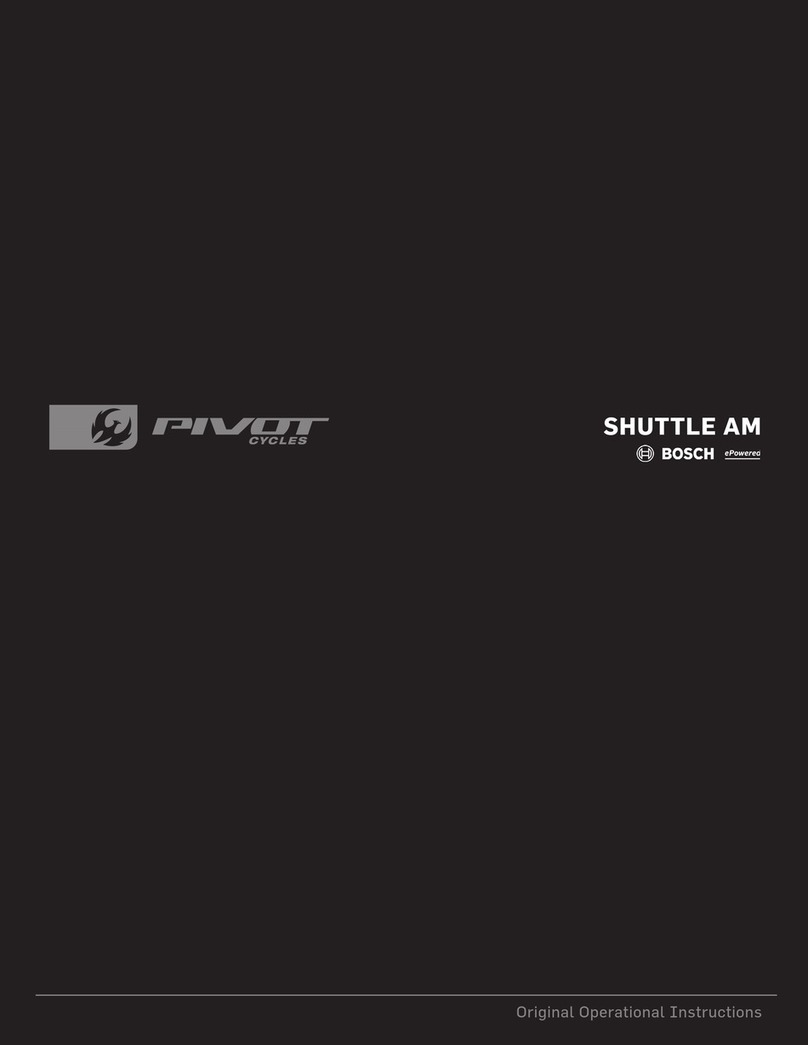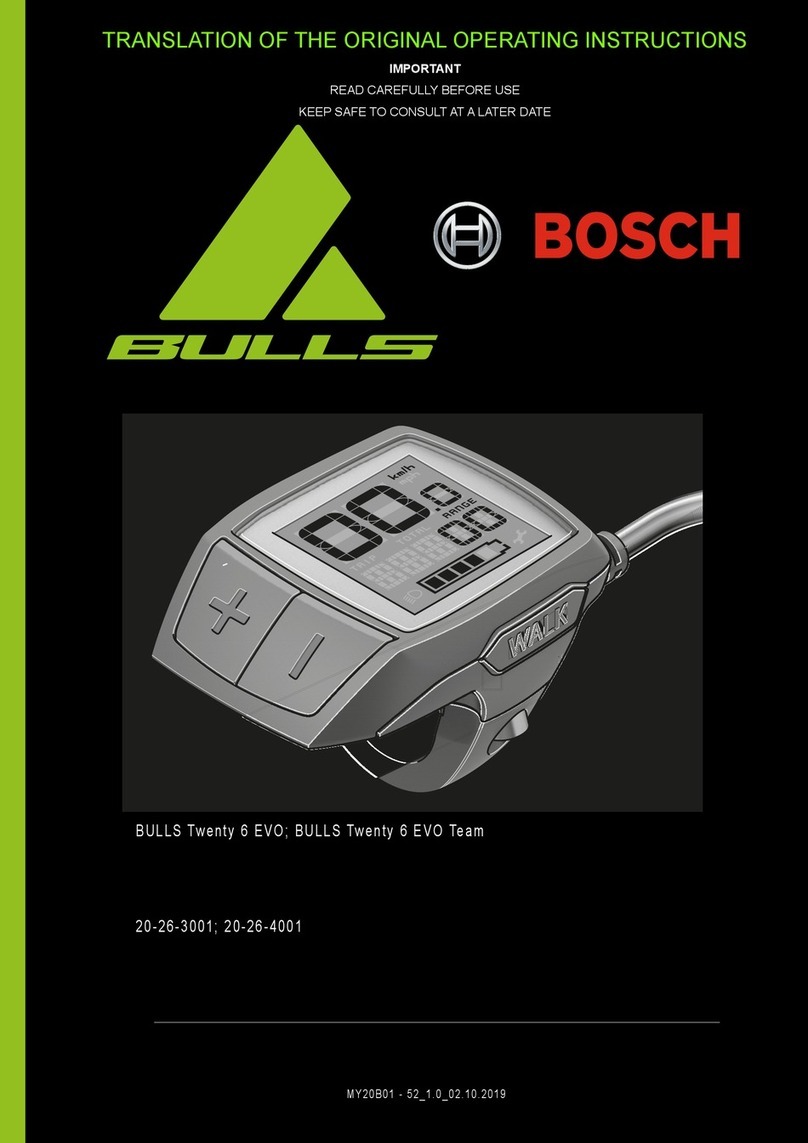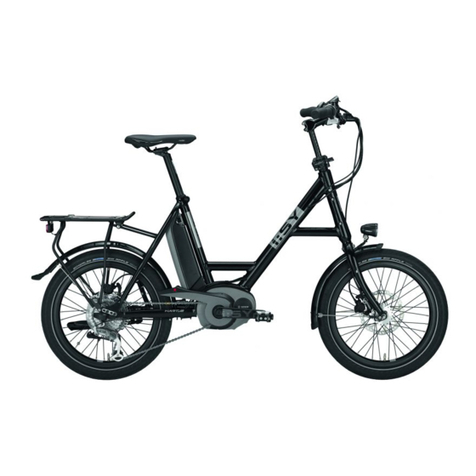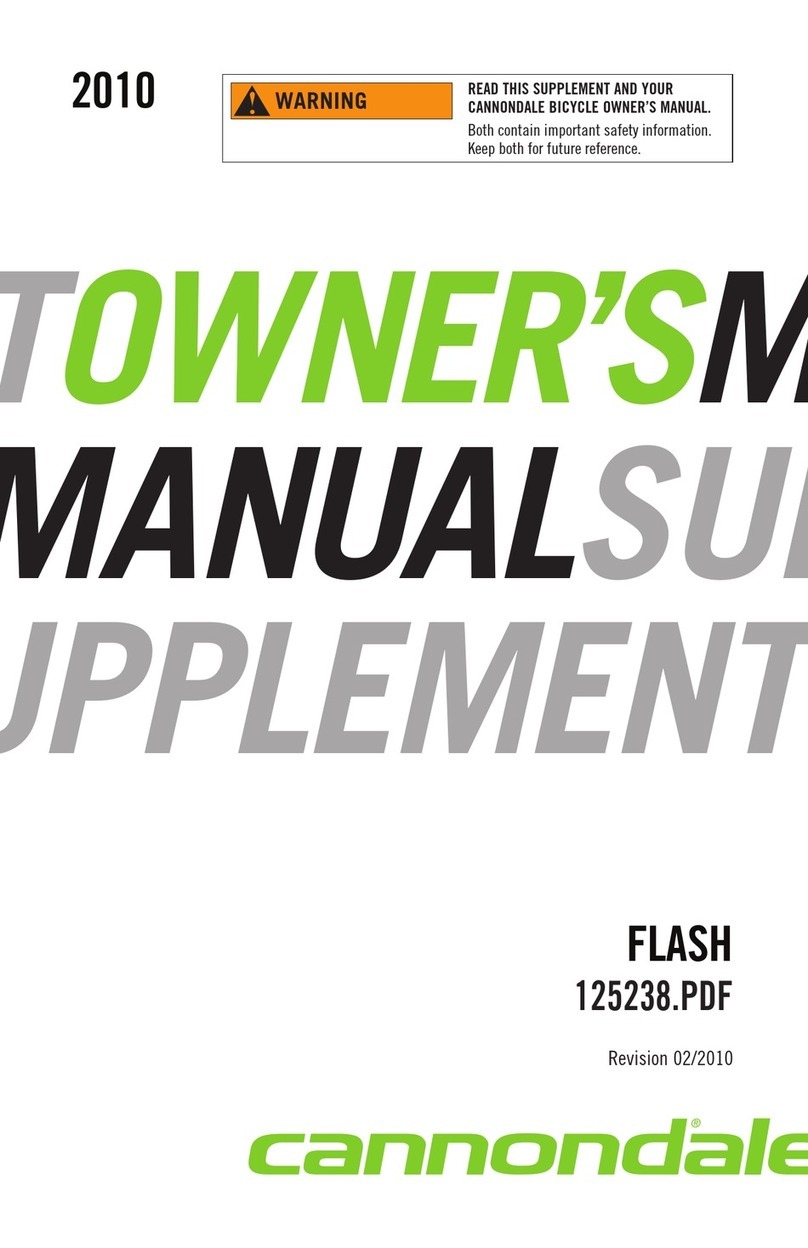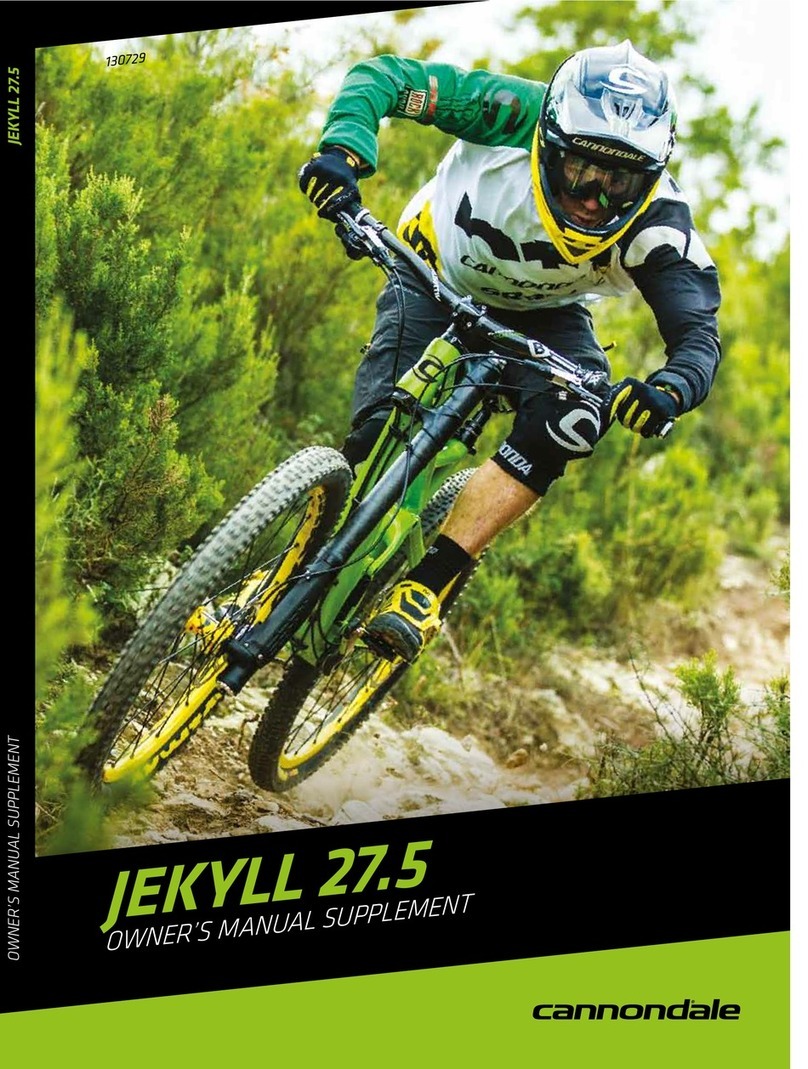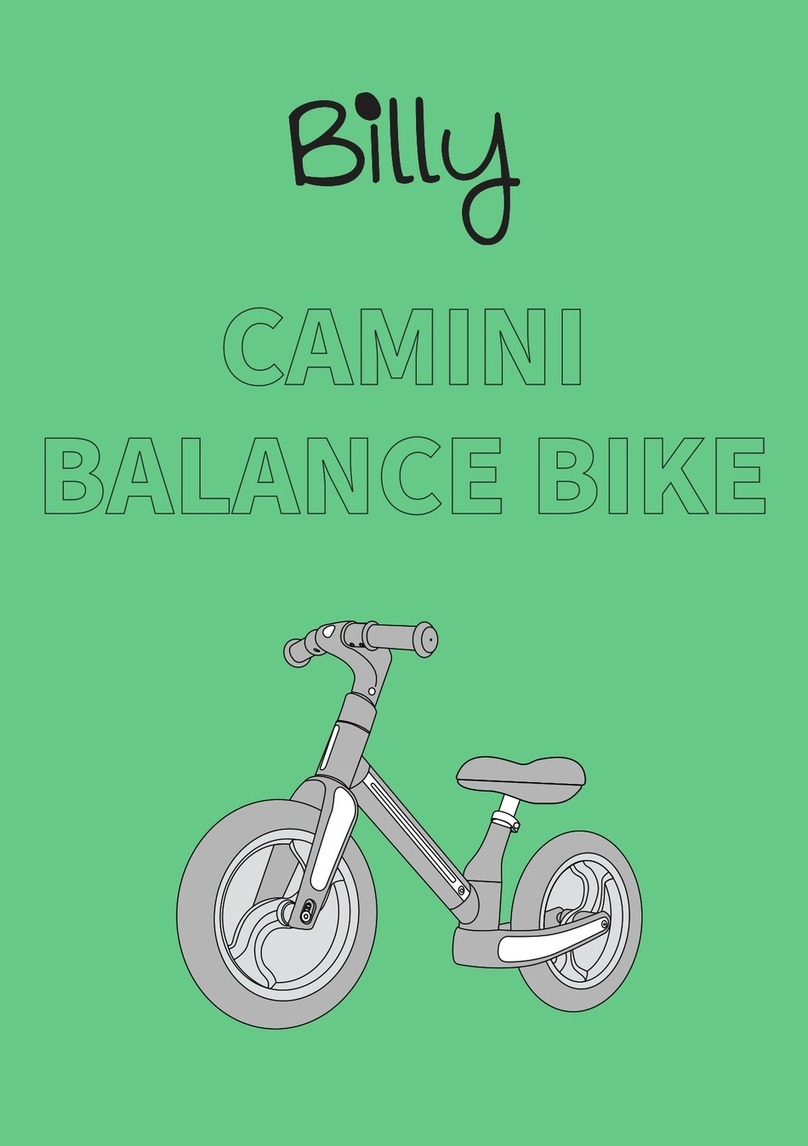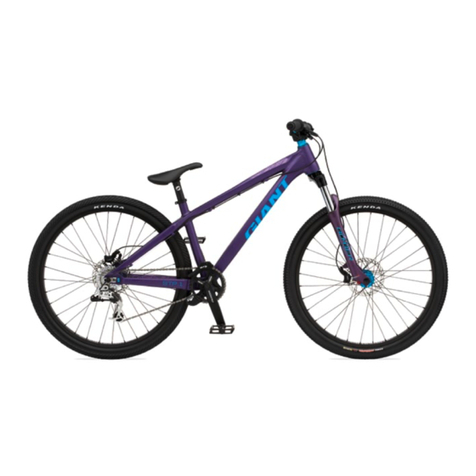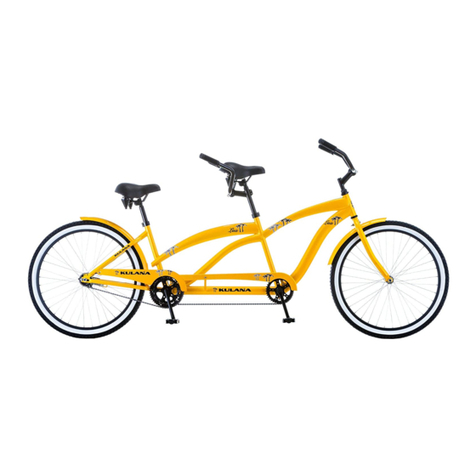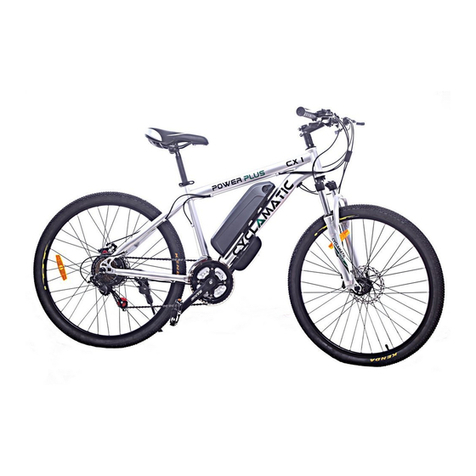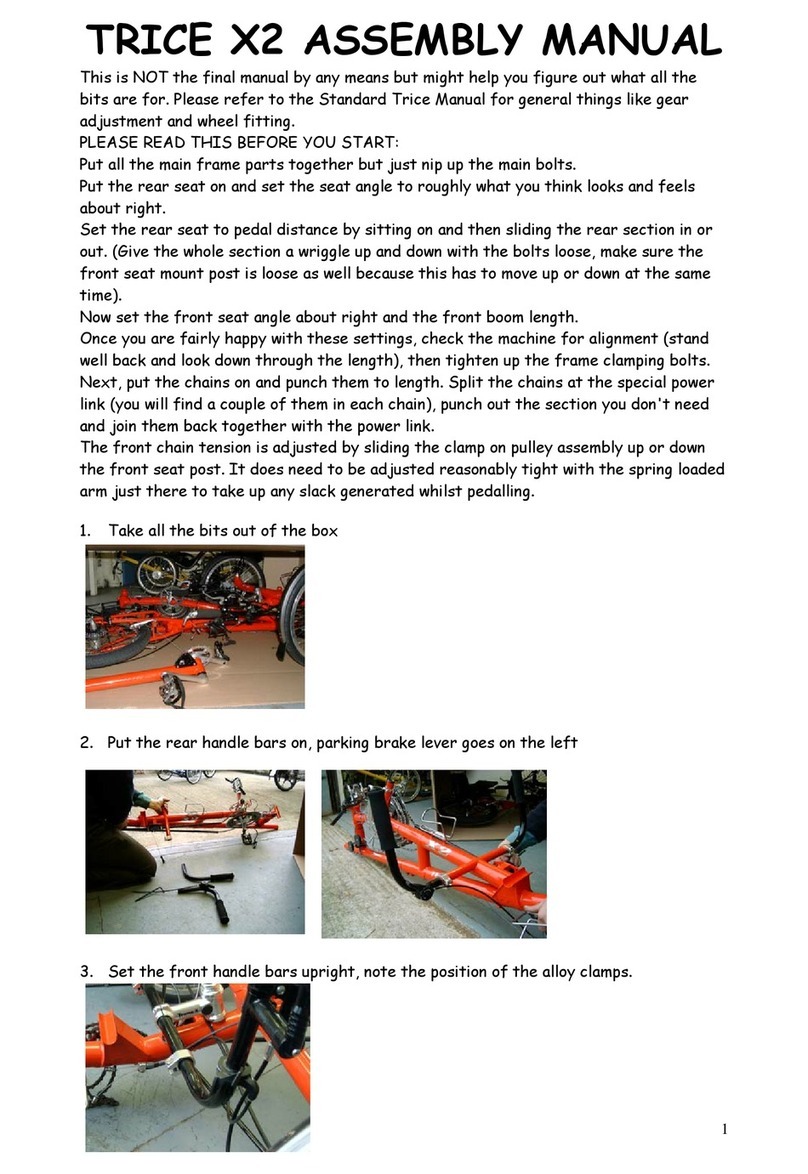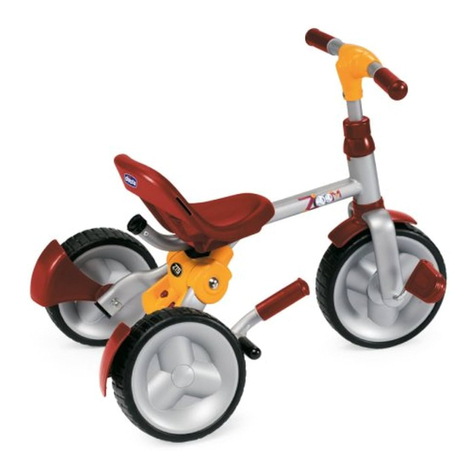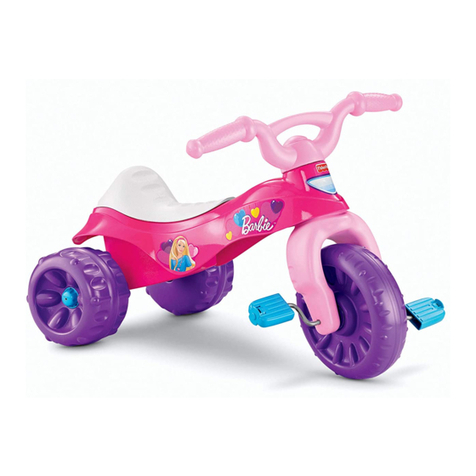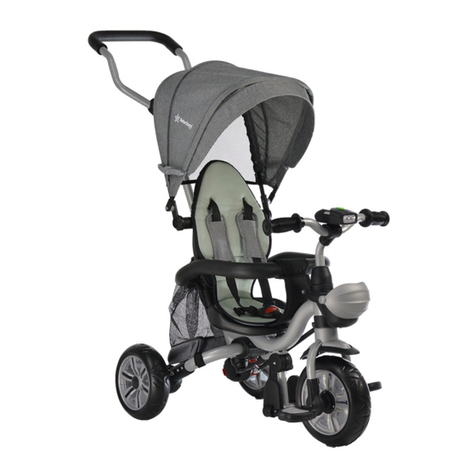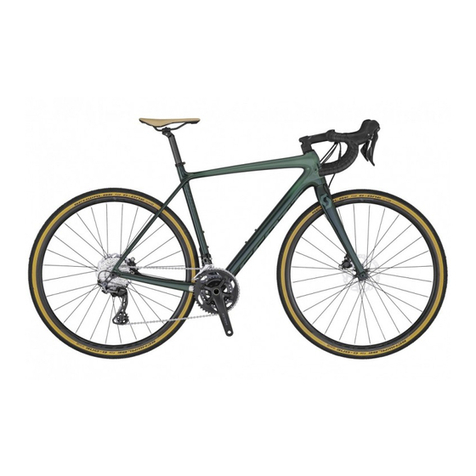Bosch WHYTE E-Lyte 140 User manual

ATTENTION!
Read this manual before
rst ride
EN | ENGLISH
EPAC Owners Manual Version 1.0 (2024)
This document is not the complete manual for your EPAC. This manual contains important safety, performance and service information.
Read it before you take the rst ride on your new electric bicycle (eBike), and keep it for reference. Additional safety, performance and
service information for specic components such as suspension or pedals on your eBike, or for accessories such as helmets or lights that
you purchase, may also be available. Make sure that your authorised retailer has given you all the manufacturers’ literature that was included
with your eBike or accessories. This manual can be downloaded from our website to access all the updated relevant information about the
use and care of this EPAC and it’s components, as well as information about spare parts, apps, warranty terms, etc.
E-Lyte 140
150


WELCOME
Welcome to the Whyte Bikes
family. Before you get riding on
your new E-Lyte please ensure
you have read all the manuals
provided with this product
carefully. This manual contains
important user directions and
safety information to get you
riding quickly and safely.
REGISTER
Registering your bike is the ofcial
way for us to welcome you into
the Whyte Bikes family. It’s also an
important step in activating your
bike’s warranty. If you ever have
an issue, we’ll be able to handle
your case efciently and get you
back riding as soon as possible.
It’s easy and only takes a few
minutes. Please follow this link
https://whytebikes.com/pages/
registration

INDEX
01 INTRODUCTION
1.1 MANUAL INFO & SYMBOLS .................................................
1.2 PRODUCT WARNINGS ..........................................................
1.3 RIDER ADVICE ...........................................................................
02 RIDE INFO.
2.1 OUT THE BOX ............................................................................
2.2 FRAME MOUNTS ....................................................................
2.3 PRE-RIDE CHECKS.................................................................
2.4 AFTER CRASH...........................................................................
03 RIDER REQUIREMENTS
3.1 LEGAL REGULATIONS ...........................................................
3.2 USAGE CLASSIFICATION ....................................................
3.3 USAGE CATEGORIES ............................................................
3.4 SAFETY EQUIPMENT..............................................................
3.5 RIDE CONDITIONS..................................................................
04 E-LYTE
4.1 COMPONENTS ..........................................................................
4.2 GEOMETRY ................................................................................
4.3 SET UP .........................................................................................
05 SYSTEM CONTROL
5.1 REMOTE FUNCTIONS.............................................................
5.2 START UP ON/OFF..................................................................
5.3 ASSIST MODES & PUSH ASSIST......................................
5.4 WIRELESS SHIFTING, LIGHTS, CONNECTIVITY........
06 CONNECTIVITY
6.1 BOSCH FLOW APP ..................................................................
07 CHARGING
7.1 SAFETY ..........................................................................................
7.2 PRODUCT SPECIFICATION..................................................
7.3 CHARGER START UP & TECHNICAL DATA ................
7.4 CHARGE PORT LOCATION .................................................
7.5 ERROR CAUSES, MAINTENANCE & DISPOSAL .......
08 DRIVE UNIT
8.1 SAFETY .........................................................................................
8.2 COMPONENTS ........................................................................
8.3 OPERATION ...............................................................................
8.4 MOTOR DISPOSAL .................................................................
09 BATTERY POWER
9.1 COMPACT TUBE 400 .............................................................
9.2 BATTERY REMOVAL ..............................................................
9.3 TRANSPORT & DISPOSAL .................................................
PAGE 05
PAGE 06
PAGE 07
PAGE 08-09
PAGE 10-11
PAGE 12-13
PAGE 14
PAGE 15
PAGE 16
PAGE 17
PAGE 18
PAGE 19
PAGE 20
PAGE 21
PAGE 22-25
PAGE 26
PAGE 27
PAGE 28-29
PAGE 30
PAGE 31-32
PAGE 33
PAGE 34-35
PAGE 36
PAGE 37
PAGE 38
PAGE 39
PAGE 40
PAGE 41
PAGE 42
PAGE 43
PAGE 44-48
PAGE 49
10 RANGE EXTENDER
10.1 POWERMORE 250 ................................................................
10.2 FITTING & TECHNICAL DATA .........................................
10.3 CHARGING...............................................................................
10.4 OPERATION, STORAGE & MAINTENANCE...............
10.5 TRANSPORT & DISPOSAL................................................
11 ELECTRICAL COMPONENTS
11.1 WIRING IDENTIFICATION ....................................................
11.2 TOP TUBE CONTROLLER ...................................................
12 MAINTENANCE & SERVICING
12.1 CLEANING & LUBRICATION .............................................
12.2 REAR SHOCK ..........................................................................
12.3 SEATSTAY ROCKER LINK ..................................................
12.4 CHAINSTAY ..............................................................................
15.5 REAR TRIANGLE ....................................................................
12.6 BEARINGS & WASHERS ....................................................
12.7 CHAIN GUIDE REMOVAL ...................................................
12.8 BRAKES.......................................................................................
12.9 TYRES & RIMS.........................................................................
12.10 COMPONENT LIFE SPAN.................................................
12.11 WHEEL AXLE...........................................................................
13 RIDE CHANGES ..................................................................................................
14 TRANSPORT.....................................................................................................
15 DISPOSAL .........................................................................................................
16 BOSCH SERVICE RECOMMENDATIONS .........................................
17 DECLARATION OF CONFORMITY........................................................
18 WARRANTY .....................................................................................................
PAGE 50
PAGE 51-52
PAGE 53
PAGE 54
PAGE 55
PAGE 56
PAGE 57
PAGE 58-59
PAGE 60-62
PAGE 63
PAGE 64
PAGE 65
PAGE 66
PAGE 67
PAGE 68
PAGE 69
PAGE 70
PAGE 71
PAGE 72
PAGE 73
PAGE 74
PAGE 75
PAGE 76
PAGE 77

01 - INTRODUCTION 1.1 Manual Info & Symbols
5
MANUAL SYMBOLS
WARNING!
This symbol indicates a hazardous situation which could result in
serious injury or death. Riding bicycles can result in loss of control or
falls which may result in injury or death, this manual doesn’t always
repeat the warning of possible injury or death.
CAUTION!
This symbol indicates a potential hazardous situation which could result
in a minor or moderate injury. This symbol may also alert against unsafe
practices. The symbol will also be used as a safety alert to indicate a
situation where damage to the bicycle/EPAC will void your warranty.
INFO
This symbol indicates to the reader that the information is important to
the user and product.
PLEASE NOTE: This manual was drafted in the English language and may
have been translated to other applicable languages. This manual assumes
that you have basic knowledge or experience of riding pedelecs/bicycles.
Thanks for choosing to purchase this Whyte product. We hope you will
enjoy all the benets of its advanced design and engineering.
This manual will guide you through the set-up, safety and operation
procedures that are specic to your Whyte bike. Please read it carefully,
it is essential you read this ‘EPAC Owners Manual’ for your own safety and
others around you. Failure to do so could lead to damaging your product
and injury.
Your Whyte Bike’s component specications that are tted as standard
may be obtained from the Whyte Bikes website www.whytebikes.com.
Please remember, if you are in any doubt about your ability to safely
assemble, service, or repair your Whyte bike, DO NOT RIDE IT and instead
arrange for a professional bicycle mechanic at your local Whyte retailer
to do the job correctly.
Bundled with this manual may be some of the respective manufacturers
instructions and manuals for the branded parts that are tted to your
Whyte bike. Please take time to study all the relevant instruction manuals
to ensure you have a continually safe and well set-up bike before every
ride.
Happy and safe riding.
INFO
Whyte Bikes website www.whytebikes.com

Inuences - Never ride your eBike/pedelec whilst using
headphones. Never ride whilst operating your mobile phone
or other electronic device. Never ever ride your bike under the
inuence of alcohol or drugs. Failure to follow these strict rules
could lead to a serious accident or even death.
Riding conditions - Under wet and slippery conditions please
consider your cornering and braking. Make adaptions to your
riding by decreasing your speed, braking earlier, and gradually
applying braking force. Braking distance is likely to be signicantly
increased especially in off- road conditions. Ensure you ride at an
appropriate speed for the conditions, terrain, and your ability.
Bicycle carrier - Child carrier or seat - Trailer
Whyte bicycles are only designed and tested for use by one
person at a time. Carrying a child, pet, or cargo load on your
Whyte bicycle is at your own risk. If you choose to install an
accessory on your E-Lyte model such as a child carrier or a
trailer, make sure it is compatible and refer to the manufacturer’s
instructions. Do not attach a child carrier, trailer, or similar
accessory to a composite or carbon bre part or component,
either directly or indirectly. For example, do not attach a trialer to
a rear axle when the rear triangle is made of composite or carbon
bre. Likewise, do not attach a trailer to a composite or carbon
seat-post or a child carrier to a composite or carbon fork.
Failure to follow the warnings in this manual may result in damage
to the components on your bicycle and will void your warranty,
but, most importantly, may result in serious personal injury or
death. If your bicycle exhibits any signs of damage, do not use it
and immediately take it to your authorised Whyte Bikes retailer for
inspection.
01 - INTRODUCTION 1.2 Product Warnings
The Whyte Bosch system can only be activated when there is sufciently
charged battery installed. Please check the ‘CHARGING’ section of this
manual which shows how to charge your bicycle safely. If a sufciently
charged battery is installed and the eBike system is switched on, pedal
assistance can be engaged when pedal force is applied. For all pedal
assist modes please nd the correct operating system in this manual.
6
Bosch Power - Your Whyte/Bosch bicycle features a powerful
pedal assist when force is applied to the pedals. Familiarize
yourself with your bike’s ride and pedal assist characteristics in a
safe and at environment. Ensure you feel comfortable with your
bikes performance before riding in public areas where you may
put other peoples safety at risk.
Keep your ngers away - Do not place your ngers or tools near
the Drive unit. Maintenance and repair of the drive unit should
only be performed by an authorised Whyte Bike service centre.
Modications - Do not modify the Bosch Drive unit or any
components directly connected to the drive unit. Maintenance
and repair of the drive unit should only be performed by an
Authorised Whyte Service Centre. Any attempt to modify the
Drive unit may result in serious personal injury or death, and will
immediately void the bicycle’s warranty.
Tyres - Never inate a tyre beyond the lower of the two values
of the maximum pressure marked on the tyres sidewall and the
maximum pressure marked on the rim that the tyre is installed
on. Exceeding the recommended maximum pressure may blow
the tyre off the rim, which could cause damage to the bike and
injury to the rider and bystanders.

01 - INTRODUCTION 1.3 Rider Advice
Rider advice
Riding an eBike offers a very different experience to riding a conventional
bicycle with no motor. The injection of power and increased weight can
change your riding approach. Below are some considerations to ensure
safe riding, reduce component wear, and increase battery range.
• Additional weight can affect braking distances. Consider your speed
when entering corners and trail features. Pedalling through corners
or trail features will increase your speed and may exceed the riders
control.
• Shifting gears efciently dependant upon gradient and terrain
ensures an efcient cadence reducing wear to drive-train
components. This will also extend the battery life of the eBike.
• Check tyre pressures regularly to ensure optimum grip and roll
efciency. Store the eBike indoors and where possible avoid storing
in temperatures lower than 5 degrees.
Rider advice
Ensure that the eBike is properly sized for the user. Check your owners
manual for assistance with size adjustments. Please ensure you have read
the sections in your owners manual regarding set up, mechanical checks,
and safety checks. Please see advice below specic to EPACs.
• Check battery charge level prior to every ride.
• Ensure you are familiar with the display functions.
• Ensure you are familiar with the remote functions.
• Make sure the bike is disconnected from the charger before every
ride.
Please note the use of a Pedelec/E-MTB by children or adolescents under
the age of 14 is not recommended and illegal on UK public pathways.
Please check your regions laws and restrictions.
Fellow riders and your environment
Always be courteous to other trail users. Use extra caution around
domestic animals, such as dogs and horses. Give other trail users right-
of-way in all situations. Take care in urban areas where human trafc is
greatly increased.
The E-Lyte has been designed for off-road riding. Please see the
‘regulations and usage’ section of this manual to learn about your bikes
capabilities. This bike is not designed for extreme forms of riding that
include hardcore Dirt Jumping, Free-riding, Downhill, or North Shore trails.
Riding your bike in environments that it hasn’t been designed for could
lead to mechanical failure and put the rider at risk.
Public roads
Before riding your Whyte E-Lyte, please inform yourself of all applicable
legal requirements and regulations in your country, state, and/or province.
There may be restrictions on riding your E-Lyte bicycle on public roads,
cycling paths, and/or trails. There may also be applicable helmet and light
requirements, age restrictions, license or insurance requirements. Whyte
Bikes encourages its bike owners to research all legal requirements for
their own safety. Failure to do so puts the rider and others around them
at risk, voids warranty, and support from Whyte Bikes will not be offered.
As laws and regulations regarding electric bicycles vary by country and/
or state and province and are constantly changing, please make sure to
obtain the latest information. Please read this manual fully and if you have
any further questions please contact your Whyte Bikes retailer.
7

02 - RIDE INFO 2.1 Out the Box
This manual is not intended as a comprehensive guide to assembling,
servicing, or maintaining your bicycle. Please see your authorised Whyte
Bikes retailer for assembly guidance, service, repairs, and maintenance.
INFO: Specication of all the components that are tted to your
bike as standard may be obtained from the Whyte Bikes website
www.whyte.bikes.com
8
WARNING: If you are in any doubt about your ability to safely
service or repair your Whyte bike, DO NOT RIDE IT and instead
arrange for a professional bicycle mechanic at your local Whyte
retailer to do the job correctly.
WARNING: Before any ride, check all xings tight and secure,
this is very important to ensure the bikes performance and your
safety. Please read the Pre-Ride Checks section of this manual
and learn what is required to operate this bicycle. Correct
tightening force on fasteners (nuts, bolts and screws) is critical.
Too much force can cause damage to the xing and too little
force could cause them to undo or rattle loose. Where indicated
in the instructions or printed on the xing, please adhere to the
recommended torque specication. Please see the table to the
right of this page for recommended tools and torque settings.
Tools Required For Assembly:
• 4,5,6,8mm Allen key
• Adjustable spanner
• Bicycle Pump
• Torque Meter Wrench
(Optional)

02 - RIDE INFO 2.1 Out the Box
When unboxing your new Whyte eBike you will nd a Whyte Charger
Case containing numerous manuals (Including this manual). Please
ensure you read all relevant literature prior to assembly or riding your
eBike. Relevant manufacturer manuals for your eBikes components will
be provided. Ensure all documents are retained for assistance with
maintenance, cleaning, and warranty.
In addition to your charger case there will be a accessories box
containing components that are specic to your eBike. Follow the
instructions below or please contact your Whyte retailer for any support
required.
Please note: the Whyte charger box and accessories box will differ
between bike models and may not reect the illustrations in this manual.
Blanking grommets for the cable ports are provided incase internal cable
headset is retro-tted. Please consult your Whyte Retailer for further
details.
9
Tools Required
• 15mm Spanner
• Philips Head Screwdriver
Accessory Part Instructions:
In the bicycle accessories kit you will nd numerous components
relevant to your bicycle. If your bicycle is supplied with pedals you
will need a 15mm spanner to t them to the cranks. Ensure you have
identied the right and left pedal prior to installation. Tighten pedals to
a recommended 40.2-42.9 Nm (350-380 lb/in). A Philips screw driver is
required to mount reectors to your bicycle. Reectors are a crucial part
of the safety system and must not be removed. Before riding your Whyte
eBike please inform yourself of all applicable legal requirements to ride

02 - RIDE INFO 2.2 Frame Mounts
Your E-Lyte has been designed with 2x frame mount locations. With an
‘Upper’ and ‘Lower’ mount the rider has the freedom to mix and match
numerous congurations of bottles, tools, and even an additional battery.
All E-Lyte models are supplied with a ‘Bosch Adapter Mount’ ‘D’ and
‘Bosch Bottle Cage’ (E). The Bosch PowerMore 250 ‘I’ is only specied with
certain Models. For further details regarding the PowerMore 250 ‘I’ please
refer to the relevant section of this manual
LOWER MOUNT: When using the Bosch Adapter Mount ‘D’ in the lower
position, there are 2x available options to the rider. OPTION 1 - Clipping
in the Bosch Bottle Cage ‘E’ allowing a water bottle to be tted. OPTION 2
- Clipping in the Bosch PowerMore 250 ‘I’ range extender battery (Please
see instructions and product details for the Bosch PowerMore 250 ‘I’ in
this manual).
UPPER MOUNT: No accessories are supplied for the upper mount. This
mount can accommodate a FIDLOCK 450mm Bottle (B) or mounts for
tools and spares. Please note the small size frame can not accommodate
the FIDLOCK 450mm Bottle (B). Pay attention to the warning below
regarding xing lengths.
10
Tools Required
• 3mm Allen Key
• T25 Torx Screwdriver
A
Option 1
Option 2
B
F
H
C
E
D
G
Upper mounted bottle
and adapter not
supplied with bike
Lower mounted bottle
and adapter supplied
with all bike models
WARNING: Take great care when installing xings to the frame
mounts. Always use original xings where possible. Never
use a xing longer than 10mm as longer screws may come
into contact with electrical components. Any damage to the
electrical components caused by an incorrect xing length
could be fatal and void your Whyte warranty. Please consult
your Whyte Retailer for further guidance if required.
G

02 - RIDE INFO 2.2 Frame Mounts
11
WARNING: Pay attention to frame decals indicating
the maximum insertion length for screw xings.
Always measure the thread length of screws prior
to installation. Failure to check screw lengths could
damage electrical components and cause serious
injury.
Max.
Thread
Length
Frame Decal
WARNING: Where possible ALWAYS use original xing. Never use a xing
longer than 10mm as longer screws may come into contact with electrical
components.
Max.Thread
Length
10mm

02 - RIDE INFO 2.3 Pre-ride Check
Pre-Ride Check
Routinely check the condition of your bicycle before every ride.
Regardless of ability and experience level, you should read all of your
Owners Manual (Assembly Safety Equipment, Pre-Ride Check, Safety
Checks, And Set Up) and carry out all the required checks. In addition,
make sure you are comfortable operating the eBike’s controls and are
familiar with all aspects of your bike.
• Make sure nothing is loose. Lift the front wheel off the ground by
approximately 5cm (2 inches), then let it drop and bounce on the ground.
Does anything sound, feel or look loose? Then do a visual and tactile
inspection of the whole bike. Can you nd any loose parts or accessories?
If so, secure them. (Frequency: Before every ride)
• Tyre pressure. Make sure tyres are correctly inated. Check by pushing
the bike down into the oor, while looking at how the tyre deects. Check
Manufacturer’s recommended tyre pressures indicated on the side wall.
Adjust the air pressure if necessary. (Frequency: Before every ride)
• Tyre condition. Spin each wheel slowly and look for cuts in the tread and
side wall. Replace damaged tyres, do not ride on them. (Frequency: Before
every ride)
• Wheels are true. Spin each wheel and check for side-to-side rim
movement. If a rim moves side to side even slightly take the bike to a
Whyte retailer to have the wheel trued. (Frequency: Before every ride)
• Ensure there is sufcient battery charge before setting off (Frequency:
Before every ride)
• Check that the display and control functions are operational (Frequency:
Before every ride).
WARNING
It is critical that the checks above are completed
before every ride.
Brake Lever Adjustment:
INFO
Please note front and rear brake levers change sides dependant
upon country/state. Ensure you identify which brake lever
operates each brake.
Whyte recommends that at least the index ngers have the range to
reach the brake levers easily. Brake lever adjustment can be achieved -
please consult brake manufacturers manuals or by consulting a Whyte
retailer for further details.
INFO
Take care during assembly not to damage the discs, callipers,
or pads when installing the wheels. With hydraulic brakes, never
apply pressure to the levers with the wheel removed.
12

02 - RIDE INFO 2.3 Pre-ride Check
WARNING - As with all mechanical components, the bicycle is
subjected to wear and high stresses. Different materials and
components may react to wear or stress fatigue in different
ways. If the design life of a component has been exceeded, it
may suddenly fail possibly causing injuries to the rider. Any form
of cracking, scratches, fraying or change of colouring in highly
stressed areas indicate that the life of the component has been
reached and it should be replaced.
Control Checks
Checking over your bike controls prior to every ride is critical to the
riders safety. These checks must be carried out after assembly.
• Brake function.
Squeeze the brake levers. Can you apply full braking force at the
levers without having them touch the handlebar? Try to move
the bike forwards with the brake levers squeezed. Are the wheels
locked? If not, then the brakes are not working properly. Do not ride
the bike until you have consulted your Whyte retailer.
• Wheel attachment.
Ensure the front and rear wheels are correctly secured to the fork
and frame.
• Secure seat post.
If the seat post has a quick-release clamp fastener for easy height
adjustment, check that it is properly adjusted and in the locked
position
• Handlebar and saddle alignment.
Make sure the saddle and handlebar stem are parallel to the bike’s
centre line and clamped tight enough so that you can’t twist them
out of alignment. If they are not, do not ride the bike until you have
consulted your Whyte retailer.
• Handlebar grips.
Ensure the grips are tight by twisting the handlebar grips with force
making sure they do not move. Make sure there is a plug in each end
of the handlebars.
13
INFO - Ergonomic adjustments to seat-post heights,
handlebars, and suspension set ups can affect the control,
comfort and performance of the user and bicycle. Correct set
up can have a great affect on increasing or reducing the rider
safety and enjoyment.
WARNING - Aloose or damaged stem, handlebars, grips or
extensions can cause you to lose control and fall. Unplugged
handlebars or extensions can cut you and cause serious injury
in an otherwise minor accident.

02 - RIDE INFO 2.4 After a Crash
AFTER A CRASH
Crashing and falling off your bike is part of cycling. Check yourself for
injuries. Take care of them as best you can. If necessary, seek medical
help. An apparently minor incident could have major implications later
on.
WARNING:
Carbon composite components, including frames, wheels,
handlebars, stems, crank-sets, brakes, etc. which have
sustained an impact must not be ridden until they have
been disassembled and thoroughly inspected by a
qualied mechanic.
Ensure a thorough check of the complete bike is completed before riding
the bike after a crash/fall. Damage might be obvious like a cracked frame,
forks, or bent handlebars. Less obvious damage like bent or twisted
controls on the handlebar can affect handling of the bike and will need
to be rectied. Please go through the ‘Pre-Ride’ checks supplied in this
manual. Carefully examine all areas of the frame, forks, and rims for
any dents, cracks or deformations. If you nd any signs of damage to
the frame, forks, or rims then do not ride the bike. Consult your Whyte
retailer to have the bike thoroughly inspected before riding the bike
again.
Check the seat, seat-post, stem, and handlebars are still in the correct
orientation. NEVER try to correct the position by force. Loosen xings/
bolts with the correct tools and reposition before re-tightening (Ensure
you refer to the specied torque settings).
Check both wheels are securely tted in the right position in the frame
and fork. Lift the eBike at both the front and rear to test the wheels
rotate freely. Make sure there are no dents or deformations to the rims.
Ensure the wheel runs true with no interference from the frame. Be sure
to check over brake alignment with discs and pads as this may have
been altered in the crash. Failure to carry out these checks before riding
puts the rider at risk.
WARNING: Aluminium components when deformed can break
unexpectedly. If any of your Whyte bicycle components have
been deformed or bent after a fall then the bicycle is unsafe to
ride. Please ensure damaged parts are replaced and correctly
installed. If there is any doubt do not ride your bicycle and
contact your Whyte retailer for support.
14
WARNING: A collision or impact can cause serious damage to
your bicycle and its components, causing them to malfunction
or wear out prematurely. Malfunctions can occur suddenly and
without notice, causing you to lose control of your bicycle and
suffer serious injuries,
If you discover any damage to your Whyte bike or its components, STOP
using the bicycle immediately!
Even if you can not visually observe any damage, pay close attention to
the sound of your bicycle when riding. Unusual noises or riding vibrations
can be a clear sign of damage and you should stop riding immediately.
Contact your Whyte retailer who will be able to correctly diagnose the
problem.

03 - RIDER REQUIREMENTS 3.1 Legal Regulations
INFO - Before riding your Whyte eBike please inform yourself
of all applicable legal requirements to ride safely in your
country/state. Please ensure adequate safety restrictions
are obeyed with regards to lighting, licenses, helmet and insurance
requirements. Whyte Bikes will not make any promise, representation, or
warranty regarding the use of your EPAC. Laws and regulations for EPAC’s
vary in different markets and continue to evolve, please ensure you obtain
the latest information.
An eBike/pedelec is a bicycle where the rider is assisted when pedalling.
The motor can legally go up to 250 Watts with a maximum assisted speed
of 25Km/h. Any bike that exceeds these limits is considered to be a
moped or light motorcycle depending upon country/state law.
Under EU and UK law eBikes/pedelec’s fall under the same category as
bicycles. These laws may differ or special rules may apply dependant
upon region so please take the time to educate yourself before riding. It
is extremely important to obey the regulations governing the operation
of an eBike/pedelec and the requirements regarding minimum age,
certicates, licenses, insurance and helmets.
INFO - Do not tamper with your eBike/pedelec’s electrical
system in any way. Unauthorised modications will void
your bikes warranty, and make the product unsafe, whilst
endangering the user and others. Making any changes to increase the
speed or performance could incur legal problems. Any maintenance to
the electrical system must be carried out by a professional accredited
mechanic and all replacement parts must be original. For further
assistance please consult your Whyte retailer or motor manufacturer.
Possible Legal Implications:
• The eBike/pedelec is required by law to be registered for approval
and insured. All legal requirements regarding the bike components
stated by road trafc licensing authority must be adhered to e.g.
lights, reectors and helmets.
• Whyte do not offer representation, warranty, or liability for use of
your eBike/pedelec
• Tampering with your eBike/pedelec may result in a legal offence and
termination of warranty and insurance. 15
Please check age restrictions for EPAC users in your country/state as it
is common to nd laws banning the use of EPAC’s for children on public
roads.
If you plan to ride with kids on your bicycle, please inform yourself
of all applicable legal requirements and regulations in your country/
state. There may be restrictions on riding your bicycle with certain or
any accessory(ies). This is especially true for electric and pedal-assist
bicycles.

03 - RIDER REQUIREMENTS 3.2 Usage Classication
PLEASE NOTE: STICKER CONTENTS WILL
DIFFER BETWEEN BIKE MODEL, YEAR AND
COUNTRY/STATE OF SALE.
To dene the intended use of your bike please contact your Whyte
retailer. All Whyte bikes have been tested and classied accordingly.
The purpose of this classication is to dene the test requirements
complying with the respective stress loads.
WARNING: It is critical that your Whyte bike isn’t ridden under
conditions that do not fall under its intended usage category.
Exceeding the usage category of your bike could result in
serious damage to the bike, injury, or even death.
WARNING: The maximum permitted weight should not exceed
120KG. Whyte bikes may have differing maximum permissible
weight limits, this can be found in the owners manual or on the
frame sticker. Example of frame sticker pictured to the right.
Exceeding the weight limit will damage the bike and could
result in a failure or accident.
The maximum permissible weight is calculated using the following factors:
Weight of Pedelec (Kg)
+ Weight of rider (Kg)
+ Weight of Luggage, Tools, Rucksack (Kg)
= Maximum Permissible Weight (Kg)
The sticker shown to the right can be found on the underside of
your down-tube near the headset. This sticker will display maximum
permissible weight whilst stating the bikes overall weight, cut off speed,
maximum power, manufacture year, and contact information.
WARNING: Towing is not permitted on this bicycle. Please do
not use tow ropes or trailers. Towing will void your warranty
and risks damaging the motor components.
WARNING: This bike has not been tested or approved for
mounting child carriers. Doing so will put the passengers at risk.
16

03 - RIDER REQUIREMENTS 3.3 Usage Categories
Whyte pedelecs of the category ‘1 - ROAD’ have been designed to be ridden on hard-packed road
surfaces where the wheels remain in constant contact with the surface. Pedelecs of this category
are not intended for use as touring or travel bikes. Maximum permissible weight consisting of the
rider and luggage is specied on the CE marking on your bike.
Whyte pedelecs of the category ‘2 - CROSS’ have been designed to be ridden on roads, tarred
cycle lanes, or gravel/earthy surfaces that have been sign posted for bikes. This category of bike is
intended for leisure and trekking where loss of contact between the wheels and surface may occur.
Drops must be limited to 15cm (6”) or less. Maximum permissible weight consisting of the rider and
luggage is specied on the CE marking on your bike.
Whyte pedelecs of the category ‘3 - TRAIL’ have been designed to be ridden on hard-packed
surfaces mentioned in category 1 & 2 as well as unpaved roads, rough trails, and unimproved trails
which require technical skills. This category of bike is intended for leisure, trekking, and cross
country where loss of contact between the wheels and surface may occur. Drops must be limited to
61cm (24”) or less. Maximum permissible weight consisting of the rider and luggage is specied on
the CE marking on your bike.
Whyte pedelecs of the category ‘4 - ENDURO’ have been designed to be ridden on surfaces
mentioned in category 1,2, and 3, or downhill grades. This category of bike is intended for All-
mountain and Enduro where loss of contact between the wheels and surface is common. Drops
must be limited to 122cm (48”) and speeds limited to 40km/h. This bike category is suitable for bike
parks which feature jumps, drops, roots, rocks, and loose ground. Please note bike park construction
characteristics to be suitable for this bike category. Maximum permissible weight consisting of the
rider and luggage is specied on the CE marking on your bike.
Whyte pedelecs of the category ‘5 - DOWNHILL & FREERIDE’ have been designed to be ridden on
surfaces mentioned in category 1,2,3 and 4; extreme jumping; or downhill grades on rough trails
where speeds may exceed 40km/h. This category of bike is intended for Downhill and Freeride
where loss of contact between the wheels and surface is common. This bike category is suitable for
bike parks which feature jumps, drops, roots, rocks, and loose ground. Jumps and drops can exceed
122cm (48”) on ofcial trails with purpose built landings. Maximum permissible weight consisting of
the rider and luggage is specied on the CE marking on your bike.
INFO Usage
categories meet
safety standards
‘DIN EN ISO 4210’
& ‘DIN EN 15194’.
17

03 - RIDER REQUIREMENTS 3.4 Safety Equipment
WARNING! Safety gear such as helmets may be required by
law. Please educate yourself on current laws and legislations
before riding. The use of helmets and other protective wear can
reduce serious injuries and even death.
Lights: Lights are mandatory for night riding by law, reectors are not
sufcient. Please make yourself aware of all laws and regulations for your
country/state. Riding at night or in poor visibility is dangerous. Ensure
lights are installed at the front and rear of your bicycle before riding at
night.
Helmet: Whyte Bikes strongly recommend that when riding any of
their bikes, that a helmet is worn at all times. This is regardless of the
discipline or bicycle type. Ensure the helmet is securely fastened. Failure
to wear a helmet could result in serious injury or even death.
Reectors: The reectors on your bicycle reect light, which illuminates
them, making the cyclist visible to other vehicles, pedestrians and
cyclists. They make you visible in conditions of poor visibility/light.
They are therefore a crucial part of the safety system and must not be
removed.
Please ensure all reectors are securely fastened, clean, clear of any
obstructions and exhibit no signs of damage. Do not remove reectors
from your Whyte bike, they have been installed to meet current laws and
are tted for the users safety.
INFO The user of this Whyte bike is responsible for
understanding current laws and regulations regarding bicycle
use. The rider must obey regulations and must be aware of the
penalties for their violation.
18

19
Considerations:
Speed: Always ride at a speed within your comfort zone and or
according to the conditions you’re riding in (e.g., rain, darkness or loose
dirt). This especially applies when riding in wet weather, as you’ll need
even more time and greater distance to slow down and are more likely
to crash. Give lots of room to slow down and apply brakes gently. Riding
at speeds beyond your comfort or skill level can result in a serious crash.
Even if it’s legal, it’s not always safe to be riding at high speeds on paths
or trails when other users are present.
Failure to take these potentially dangerous conditions into account can
cause a crash, leading to serious personal injury or death.
WARNING - Conditions on the road, path or trail you are riding
on can present sudden hazards. Avoid or exercise caution by
slowing your speed on dangerous terrain, including:
• Potholes
• Train tracks
• Wet, oily or icy terrain
• Gravel or sand
• Kerbs
• Wet leaves
• Speed bumps
• Drain grates
• Broken glass
• Thorns
• Steep hills
• Sharp or sudden turns
• Other hazards that can cause a puncture and/or loss of control
WARNING - As a road user, it is your responsibility to follow the
rules of the road and operate your eBike in such a manner as to
reduce your risk of a collision. Failure to follow this warning may
lead to a collision or crash, resulting in serious personal injury
or death.
Surrounding people:
Exercise caution when passing pedestrians or other cyclists. The greater
the speed difference, the greater the likelihood of a crash. Slow down
when people or pedestrians are present, as they may not be aware of
your presence and may step out in front of you. Riding with greater
speed and weight requires more care, especially around other riders.
Avoid distractions and stay focused on the road ahead. When following
other riders, maintain a sufcient enough gap to allow you to stop safely.
The higher your speed, the greater the gap should be.
CAUTION - When riding in a group, following other riders, or
riding on crowded roads, paths or trails, always maintain a gap
sufcient to allow you to stop safely.
Passengers:
Transporting passengers with your eBike is NOT permitted. Your eBike
has been designed and tested for use by one person (the rider). Any
transportation of a passenger beyond the intended design of the eBike
is at your own risk.
03 - RIDER REQUIREMENTS 3.5 Ride Conditions

04 - E-Lyte 4.1 Components
20
A - Frame
A
B
C
D
E
F
G
H
I
J
K
L
M
N
O
P
Q
R
S
T
U
V
W
X
Y
Z
B
C
D
E
F
G
H
I
J
K
L
M
N
O
P
Q
R
S
T
U
V
W
X
Z
7
8
1
2
5
4
6
3
1 - Top tube
2 - Down tube
3 - Seat tube
4 - Chainstay
5 - Seatstay
6 - Rear shock
- Saddle
- Seat post
- Seat post clamp
- Rear brake
- Cassette
- Rear dérailleur
- Chain
- Chain-ring
- Crank-set
- Pedal
- Stem
- Grip
- Brake lever
- Shift lever
- Headset
- Suspension fork
- Front brake
- Rotor
- Thru axle
- Rim
- Spoke
- Tyre
- Hub
- Dropper post lever
- Controller
7 - Top tube controller
8 - Mini remote
Y
This manual suits for next models
1
Table of contents
Other Bosch Bicycle manuals
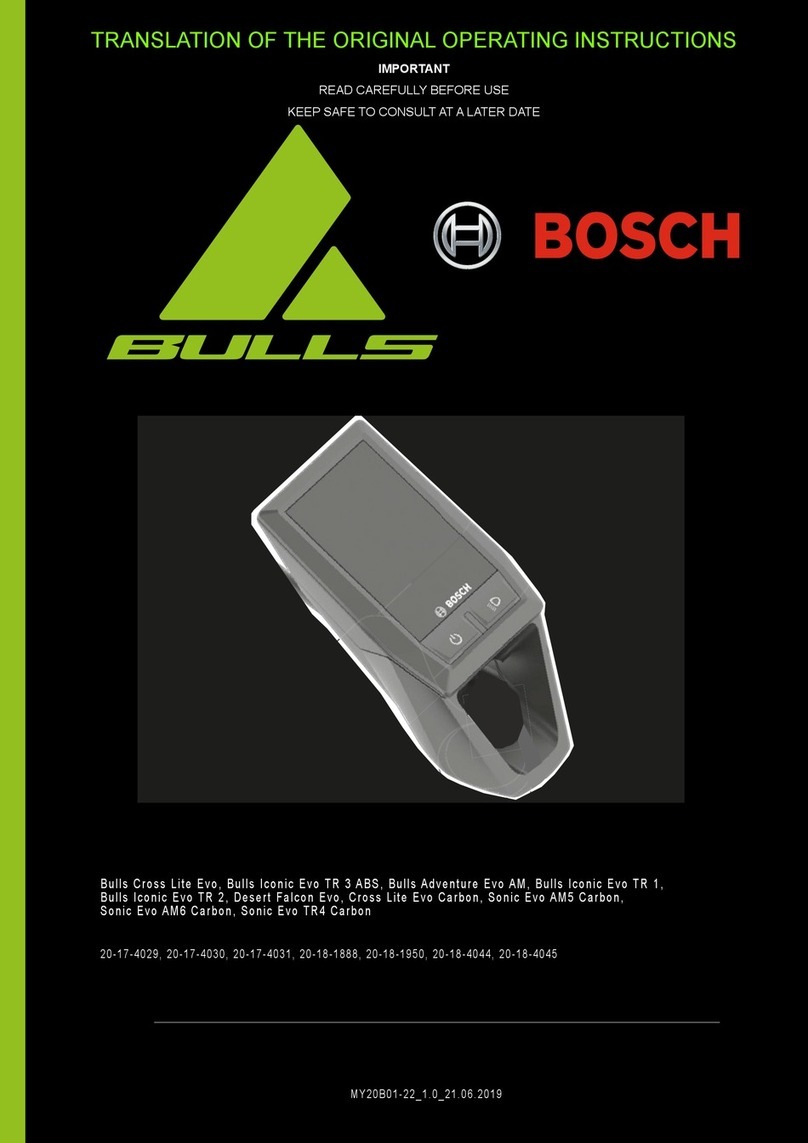
Bosch
Bosch Bulls Cross Lite Evo User manual

Bosch
Bosch Drive System User manual
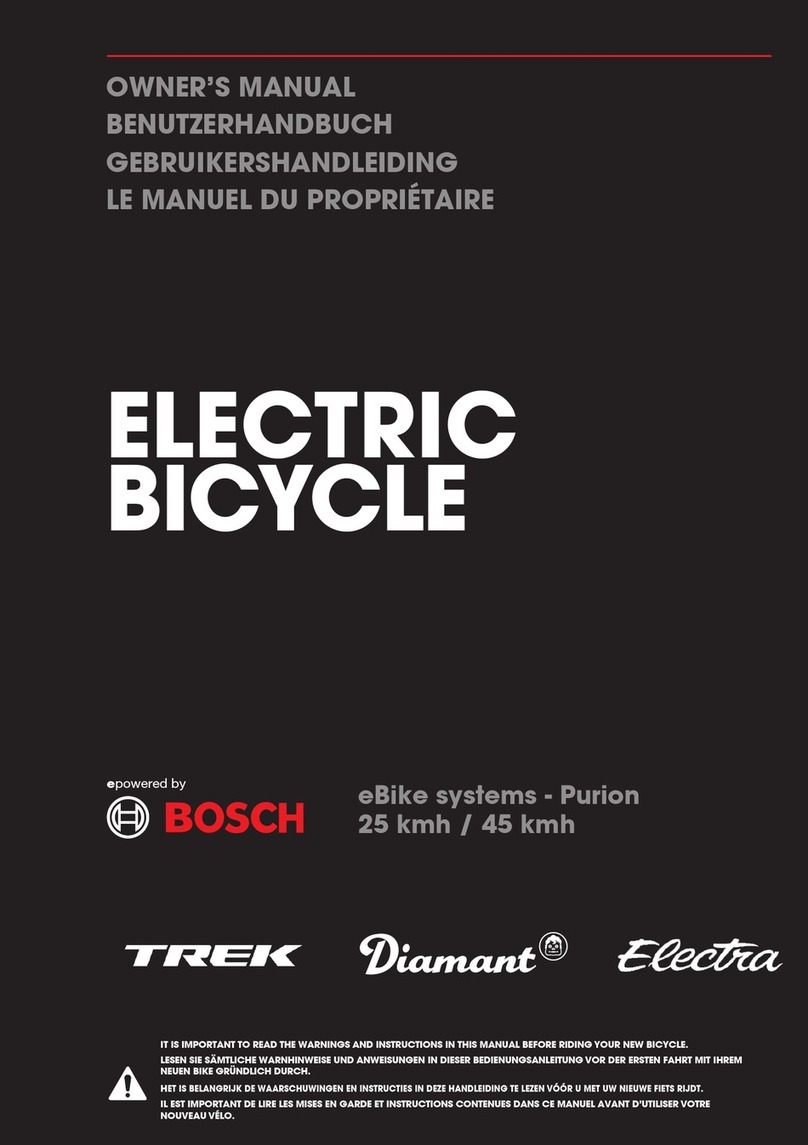
Bosch
Bosch Performance Line BDU365 User manual

Bosch
Bosch FLYER Mountain Quick start guide

Bosch
Bosch BDU336Y User manual

Bosch
Bosch Kiox User manual

Bosch
Bosch Purion BUI210 User manual

Bosch
Bosch KOGA PACE B05 2020 User manual
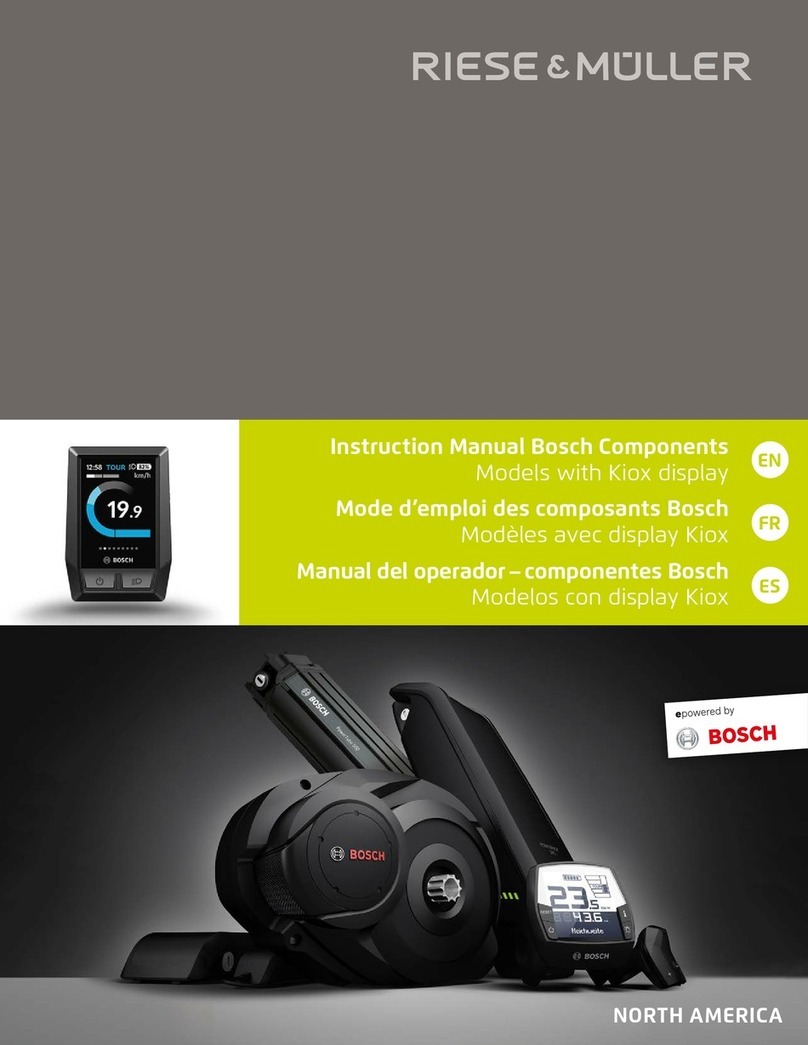
Bosch
Bosch BDU280P CX User manual
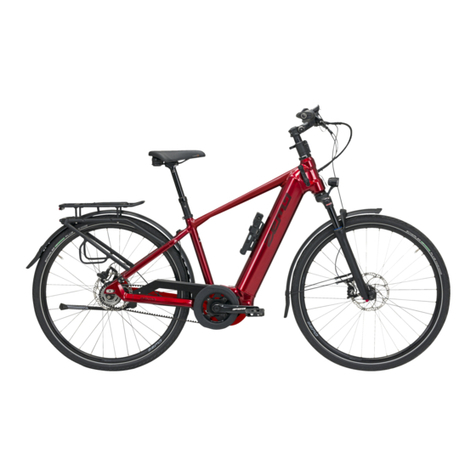
Bosch
Bosch ZEMO SU-E FS 12 Wiring diagram
